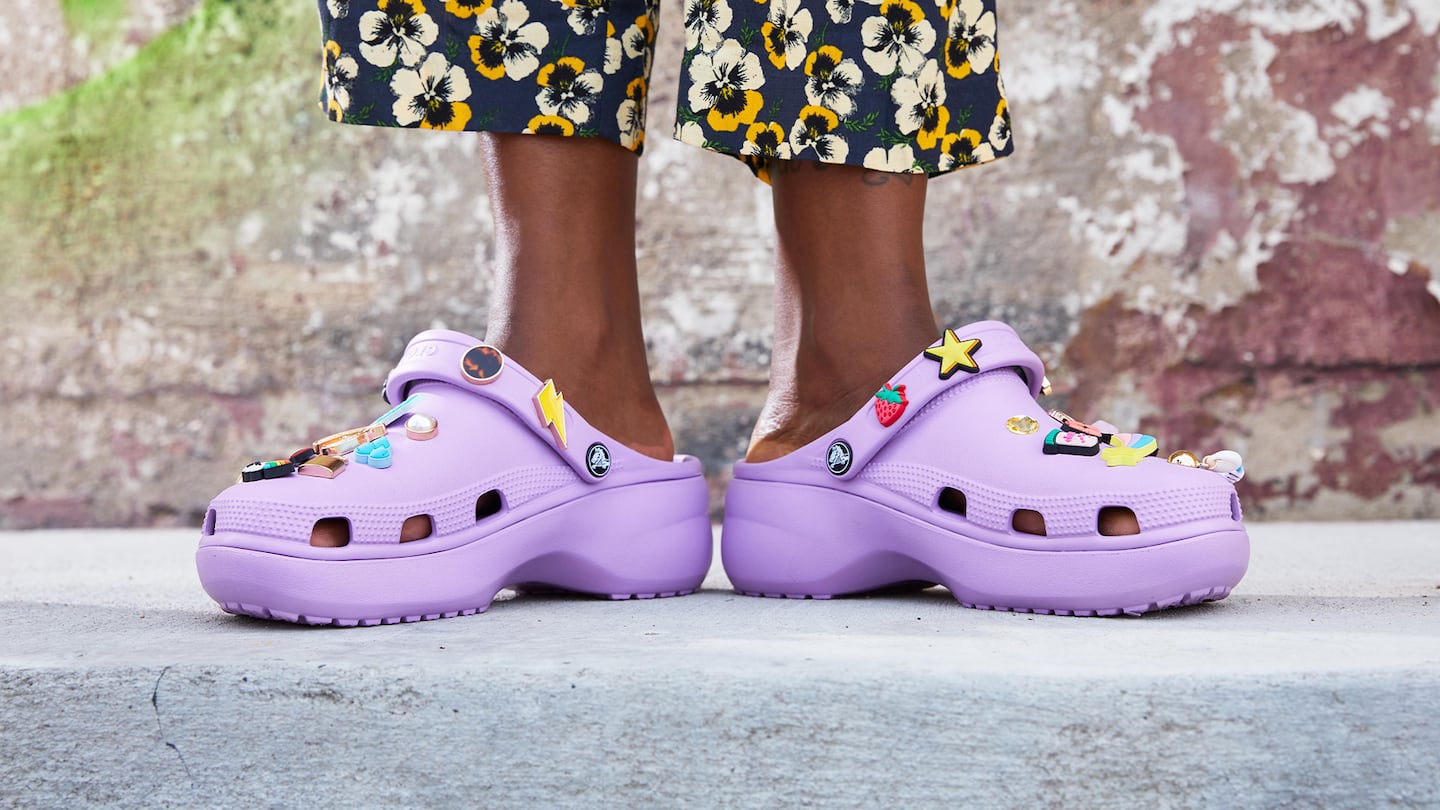
The Business of Fashion
Agenda-setting intelligence, analysis and advice for the global fashion community.

Agenda-setting intelligence, analysis and advice for the global fashion community.

Salehe Bembury is one of the most in-demand footwear designers right now. The Kanye West protege led the footwear team at Versace that positioned the brand at the centre of the luxury sneaker boom before going solo at the end of 2020.
But these days, even someone dubbed “the best sneaker designer in the world” by Donatella Versace picks up the phone when Crocs calls. Bembury recently designed a shoe for the company — a grey and white clog with a textured pattern resembling a fingerprint — that will go on sale in a few months. A photo of the shoe posted to his Instagram has racked up over 64,000 likes.
“Guess I’ll get my first Crocs,” one user commented.
They’re late to the party. Over the last few years, Crocs has shifted its image from a polarising clog favoured by doctors, nurses and others who work on their feet to an obsession for hypebeasts and fashion editors alike. The shoes regularly top Amazon’s ranking of top-selling footwear, and ranks eighth among footwear brands on Piper Sandler’s semi-annual survey of American teens. The brand expects sales to rise 60 to 65 percent this year, from $1.3 billion in 2020.
ADVERTISEMENT
“They were initially laughed at and now they are an iconic silhouette and everyone wants to join the party,” said Bembury. “It’s a beautiful, poetic love story of a product.”
The company’s best-sellers are the non-fussy, basic version of its foam clogs, which consumers flocked to during the pandemic as they were shopping for comfort over style. But collaborations with designers like Bembury and celebrities like Diplo and Justin Bieber have helped the company tap into diverse subcultures and fandoms, turning “the cringiest of shoes to this incredibly cool brand,” said James Cadwallader, co-founder and chief creative officer of Kyra Media, a Gen-Z-focused media company.
They were initially laughed at and now they are an iconic silhouette and everyone wants to join the party.
“You have everyone from icons like Jonah Hill to cheesy TikTok stars puttering around Hollywood in them now,” he said. “Crocs just keep emerging.”
Even with Covid restrictions lifting, the brand’s influence within the fashion world continues to grow. Brands like Fear of God, Alyx and Loeffler Randall have casual foam clogs of their own while Skechers and Vans make Crocs lookalikes. Even luxury brands like Bottega Veneta and Gucci sell rubber clogs now.
As the brand is enjoying the results of a turn-around strategy that was years in the making, it’s also planning ahead so that it will remain relevant in footwear.
Right Place, Right Time
Crocs have cycled through many periods of highs and lows since its 2002 launch. During the mid-2000s, the company’s clogs became ubiquitous, but the brand nearly went bankrupt during the financial crisis, drowning in excess inventory. After retailers cut back on distribution, Crocs opened hundreds of stores of its and sales picked up again.
In 2013, Crocs received a $200 million investment from private equity firm Blackstone and the company focused on wholesale distribution and expanding style options.
ADVERTISEMENT
Starting in 2017, just as the ugly shoe trend was taking off, new management began another pivot. Crocs closed hundreds of underperforming stores and cut ties with many small wholesalers, forming partnerships with large chains like Finish Line and Foot Locker instead.
“They cleaned up things beneath the surface that didn’t touch the eyeballs of fashion editors but was effectively a judicious process of turning around the financials of the company,” said Erinn Murphy, managing director and senior research analyst at Piper Sandler.
Like Nike, Crocs also began selling more shoes directly to consumers. Direct sales made up 52 percent of revenues during the second quarter of 2021 (up from 47 percent in 2019).
“Our growth strategy [includes] a distribution model led by digital commerce,” chief marketing officer Heidi Cooley told BoF in an email. “While we have made tough decisions to terminate select wholesale accounts in the past, this strategy has been important to maintaining our strong marketplace health.”
While Crocs still has a wholesale business, chief executive Andrew Rees told investors in July that the company is careful about how much product it gives to retailers.
“I’m sure there are the occasional wholesale partners that would like more products,” he said. “In fact, there are probably quite a few that would like more products, but this is an important part of managing the brand.”
Murphy also credits Crocs for cutting down on the number of styles it sells. As part of its turnaround strategy in 2017, the company cut 50 percent of its products, Murphy said. Instead, Crocs has been “repositioning the brand through the lens of our classic clog,” according to Cooley.
“They were trying to be too many things for too many people, but… decided to lean into the classic clog,” Murphy said.
ADVERTISEMENT
Focusing on a hero product can be dangerous for a brand. But Crocs maintains its relevance by releasing frequent, limited-distribution collaborations of its classic clog. Over the past year, it’s teamed up with Justin Bieber, Post Malone, and fast-food chain KFC for limited edition takes on its ubiquitous foam clog slipper (screams of both joy and terror hit the internet when its collaboration with Balenciaga, featuring a stiletto heel, were revealed at the luxury fashion brand’s Spring 2022 show in June).

“The brands dominating youth culture are the ones who are willing to hand over the keys to creative individuals and Crocs has nailed that,” said Nick Susi, head of strategy at Complex Collective. “They are doing a great job at working with the right folks.”
These collaborations, according to Cooley, are aimed at “consumers who may have not previously thought of Crocs, let alone consider wearing them.” They also help with return purchases, as do Jibbitz, Crocs’ in-house charms line, added Murphy. Jibbitz sales more than doubled in 2020.
“Jibbitz... allows individuals to create their own adventure and also stay relevant with big themes like Black Lives Matter or Pride,” she said. “It’s a substantial piece of the business that’s driving their topline because they are high margin and a great add-on product.”
In With the Cool Kids
Crocs has become a Gen-Z favourite because of its price point and accessibility, said Susi (the average pair costs about $50).
“People refer to Crocs as ugly shoes and I think Gen-Z likes that because it references how they embrace imperfections,” he said.
Teens also strongly identify with the Crocs marketing approach, he added. Crocs was also one of the early brand adopters to TikTok, sponsoring challenges and encouraging followers to partake in silly dance-offs. The company also frequently reposts social media photos, and while user-generated content isn’t unique to Crocs, it’s important to Gen-Z.
A Future with Global Comfort
Though wildly popular in the US, Crocs remain relatively niche overseas.
Cooley said Crocs is focused on growing in Asia and Europe, and is doing so by working with local influencers. It’s also leaning on collaborations, of course, like a recent one with Little Big, a Russian rave band, as well as Nongshim, a noodle brand popular in South Korea.
People refer to Crocs as ugly shoes and I think Gen-Z likes that because it references how they embrace imperfections.
Crocs is also working to protect its territory by suing 19 brands, including Walmart, for copyright infringement.
And even as customers start shopping for regular fashion again, analysts like Murphy don’t anticipate Crocs’ growth will slow down.
“Through the pandemic, consumers got comfortable with being comfortable and I don’t think that’s going anywhere,” Murphy said. “You see consumers going out in Crocs, wearing them to the mall or the airport. There’s a very strong appeal.”
Related Articles:
Why Shoppers Are Obsessed With ‘Summer Camp’ Jewellery
The company, under siege from Arkhouse Management Co. and Brigade Capital Management, doesn’t need the activists when it can be its own, writes Andrea Felsted.
As the German sportswear giant taps surging demand for its Samba and Gazelle sneakers, it’s also taking steps to spread its bets ahead of peak interest.
A profitable, multi-trillion dollar fashion industry populated with brands that generate minimal economic and environmental waste is within our reach, argues Lawrence Lenihan.
RFID technology has made self-checkout far more efficient than traditional scanning kiosks at retailers like Zara and Uniqlo, but the industry at large hesitates to fully embrace the innovation over concerns of theft and customer engagement.